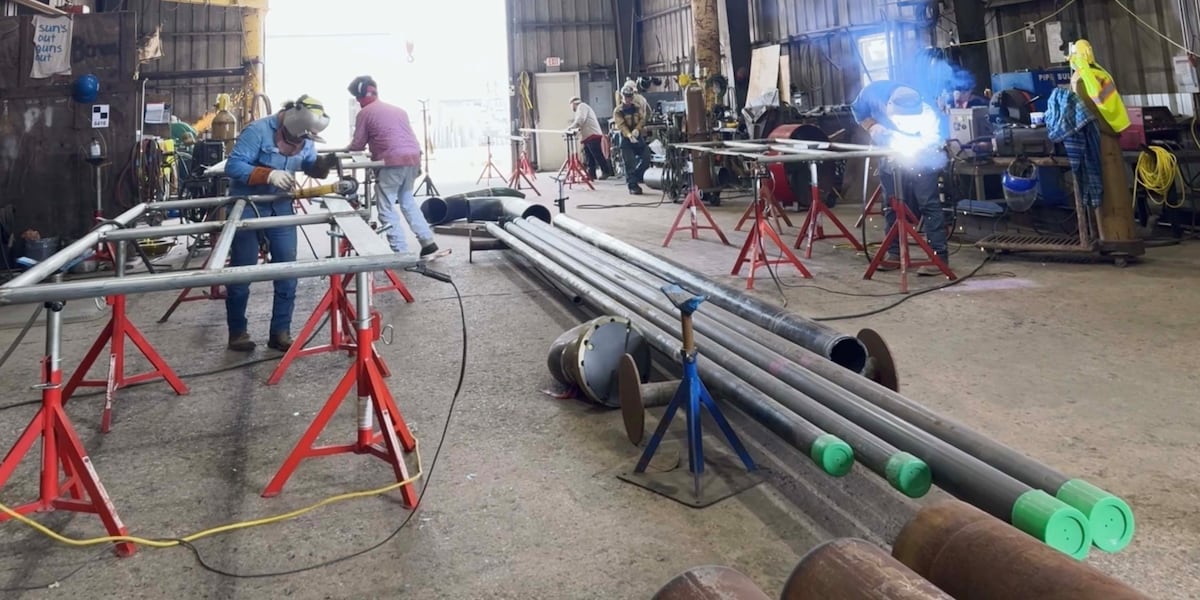GALLIANO, La. (WVUE) — James Siglar has spent nearly 30 years working in the oil fields, living the ups and downs of the industry.
“Born and raised in Grand Isle,” Siglar said. “So, I’ve been around it my entire life.”
For Siglar and his coworkers at Grand Isle Shipyard in Galliano, the good times have returned.
Fabrication yards for the offshore oil and gas industry are buzzing with activity.
Even though oil production rose under the Biden administration, the former president was often seen as hostile to the industry, especially to drilling on federal lands or offshore.
“You know, myself and my family who depend on the oil field, we feel like things are moving in the right direction now,” Siglar said.
The industry is also an easier sell for prospective employees.
“The message is clear: Oil and gas isn’t going away anytime soon,” said Josh Falgout, a senior recruiter for GIS.
Much of the production boom has taken place onshore.
From Texas to North Dakota, hydraulic fracturing — or fracking — opened up reserves that had been out of reach.
Last year, natural gas fueled about 41 percent of America’s electricity needs, according to the US Energy Information Agency.
“It’s been a revitalization of the oil and gas industry. ‘Drill, baby drill,’ that’s coming through,” said Mark Pregeant, a fourth-generation CEO at GIS. “So, we’re starting to see that uptick in our industry that’s coming through now.”
In what seems like the blink of an eye, natural gas became one of the country’s biggest exports. Specifically, LNG (liquefied natural gas), which is supercooled to minus-260 degrees, condensed into liquid form, and pumped into huge tankers for shipment overseas.
Exporters are making mind-blowing investments in LNG plants, including Venture Global’s planned $18 billion expansion of its plant in Plaquemines Parish.
Natural gas had largely been seen as a transition fuel, bridging the gap between coal and a future with renewable, cleaner sources of energy.
Not everyone is cheering the natural gas boom, especially involving LNG.
Retired oil engineer John Allaire, for one, is feeling a bit surrounded these days.
In 1998, he bought a little piece of paradise right on the Gulf Coast south of Lake Charles. A few years ago, the new neighbors moved in, a giant Venture Global LNG export facility at the mouth of the Calcasieu Ship Channel.
“This is a big grab to get it out of the ground as fast as you can,” Allaire said.
Another LNG plant is planned between Venture Global and Allaire’s property line.
“Their flare stacks will be 750 feet from my property line,” he said.
Allaire also is concerned about the long-term effects on natural gas prices for consumers.
“I can’t believe we’re exporting this valuable product,” Allaire said. “I mean, we only have X-number of years left of natural gas.”
He also worries about the effects on the natural drainage of his beachfront property.
“When it comes to putting these things in and taking out thousands of acres of wetlands, they just let ‘em do whatever they want,” Allaire said.
While three LNG terminals already exist nearby, the Louisiana Bucket Brigade counts 11 proposed facilities in Southwestern Louisiana.
“Of course, jobs are important,” said Lori Cooke, program coordinator for the Louisiana Bucket Brigade. “But we can’t throw away what’s also important — what’s more important — the culture and the lifestyle.”
The Bucket Brigade complains the state is failing to adequately monitor air quality near the plants, including for benzene, formaldehyde and other pollutants.
“We don’t really know what’s out there,” Cooke said. “We know what they say is out there, and even what they say is out there that they’re emitting is very dangerous.”
In a statement, the Louisiana Department of Environmental Quality defended the air quality monitoring, which the agency said includes three air monitors near Vinton, Lighthouse and Carlyss to detect methane, volatile organic compounds and ozone levels.
“The agency uses this critical information to keep residents and stakeholders informed with current data on the key air pollutants most relevant to public health and environmental quality near the facility,” the DEQ statement said.
Cooke questioned the adequacy of the monitors, with the closest being about 30 miles away as the crow flies.
Back at GIS, they have taken an all-of-the-above approach to energy.
“Being in the energy sector, it really doesn’t matter where it is, quite frankly,” Pregeant said.
GIS has diversified into other businesses, including coastal engineering and surveying, to designing many of the floodgates in Terrebonne and Lafourche parishes.
Today, oil and gas accounts for just 60 percent of its business.
“You’re going to need energy no matter what, whether it’s coming from solar, whether it’s coming from wind, from oil and gas,” he said. “We’d like to think by doing that, we made our business more resilient.”
However, Pregeant believes a transition to other forms of energy will take more than just the few years some advocates suggest.
“It’s just not realistic to say you’re going to switch from traditional oil and gas,” Pregeant said “The technology’s not there.”
Subscribe to the Fox 8 YouTube channel.
Copyright 2025 WVUE. All rights reserved.
